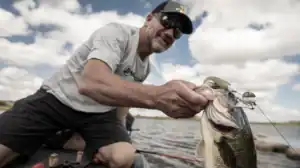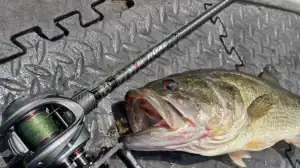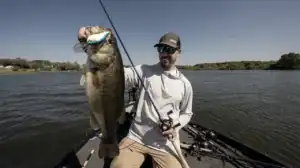Spring is a dynamic transition time, and bass anglers must be adaptable to construct a quality pattern. We jumped at the opportunity for
Bob Downey to take us through his process of breaking down water in the late spring. As temperatures hover around the mid-60s, it’s prime time for catching a mix of prespawn, spawn, and post-spawn bass. With both largemouth and smallmouth bass active, Downey leverages a diverse set of tactics to adapt to the varied conditions on the lake.
FEATURED PRODUCT (retail links)
FLIPPING SETUP
SWIMBAIT SETUP
UNDERSTANDING WATER TEMPERATURE AND FISH BEHAVIOR
The adventure starts with analyzing the water temperature, a crisp 65°F—ideal for bass activity. Downey emphasizes the importance of temperature trends as they influence bass movement and the best fishing patterns. This time of year is about adaptability; visual cues like observing fish behavior and habitat changes are crucial.
TECHNIQUES AND GEAR FOR SUCCESS
Consistently
catching bass in the spring requires a versatile approach. He keeps various rods ready, each rigged for different scenarios that the day might present. His approach is methodical: He moves quickly with a weedless swimbait to locate fish and then slows down to thoroughly fish productive spots with a Texas rig. This approach allows him to maximize each area’s potential once he starts getting bites.
INDICATORS OF SPAWNING PHASES
Downey examines each fish catch for signs of its spawning phase. Observations of physical conditions and spawning behaviors provide insights into whether the bass are prespawn, actively spawning, or post-spawn, thus allowing him to adjust locations and fine-tune his tactics accordingly.
KEY TAKEAWAYS FROM A DAY ON THE WATER
- The importance of observing environmental and fish indicators in adapting techniques.
- The effectiveness of using versatile gear and knowing when to switch tactics based on fish activity.
- The role of precise bait presentations like a Texas rig around structures like beaver houses and pencil reeds, which often harbor bass during the spring.
BOAT SETUP
Ben Swanson graduated from St. John’s University in 2024 with a degree in Communications and a minor in Environmental Studies. A lifelong avid fisherman, Ben has a keen eye for photography and video production, picking up a camera at a young age and improving on his ability to create with it as the years went on. During high school at Minnetonka, Ben and a few friends started the Minnetonka Fishing Team. This allowed Ben and teammates to fish tournaments throughout the state against the likes of Grand Rapids, Lakeville, and more. He made many friends during the experience, while winning tourneys on Leech Lake, Mille Lacs, and Minnetonka. In college, Ben was the social media manager for the school’s Ducks Unlimited chapter and helped run an annual banquet and spring bingo event.










